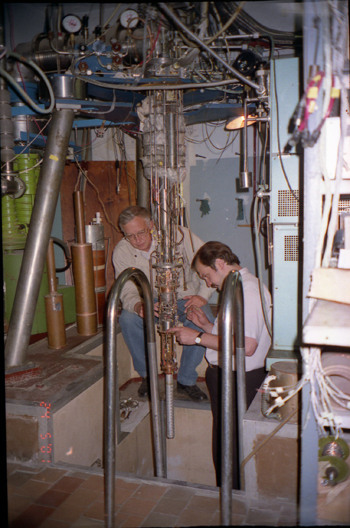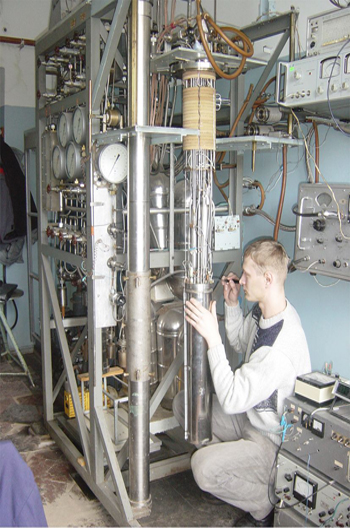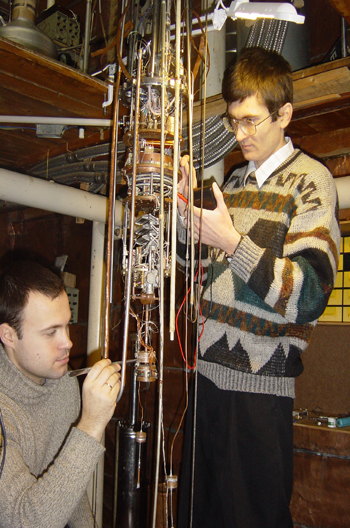THE COMPLEX FOR PHYSICAL STUDIES AT ULTRALOW TEMPERATURES The complex developed at our Department includes four refrigerators producing ultralow temperatures:
All the refrigerators and the related thermometry systems were developed and produced at ILTPE NAS of Ukraine. In 2001, the Complex for physical studies at ultralow temperatures was given the status “National Property of Ukraine” (Resolution of the Cabinet of Ministers of Ukraine N 1709 of 19.12.2001). The Complex is available for performing joint experiments at temperatures below 0.3 K. ILTPE NAS of Ukraine welcomes offers from the scientists of Ukraine and other countries and is ready to consider the corresponding physical problems.
Nuclear demagnetization refrigerator
A.A.Golub, V.A.Goncharov, V.R.Litvinov, V.A.Mikheev, E.Ya.Rudavskii, Yu.A.Tokar’, A.M.Usenko, V.A.Shvarts, “The nuclear demagnetization refrigerator with an automated system of data control, acquisition and processing”, FNT, 21, 974, 1995 
| | Placed in operation in 1985. Incorporates the following basic elements: - a dilution cryostat with a degree chamber;
- an Al thermal valve;
- a Cu nuclear demagnetization stage;
- a magnetic system;
- a thermometry system;
- an experimental device for physical studies;
- an automated system of data control, acquisition, and processing. The nuclear stage is made as a bundle of 4000 close-packed glass-fibre isolated Cu wires 0,5 mm in dia. The mean-square magnetic field of 7 T accommodates 23 moles of Cu. Minimum temperature in the coolant plate – 0,7 mK.
Residual heat gain – 0,25 nW/coolant mole.
The refrigerator is used to investigate low-temperature nuclear magnetism and phase separation in solid 3He-4He solutions.
|
Outer circulation dilution refrigerator B.N.Esel’son, V.A.Goncharov, E.Ya.Rudavskii, V.K.Chagovets, S.I.Tarapov, “The simple continuous-refrigeration dilution cryostat for production of ultralow temperatures”, Collection: “Design and Engineering of Cryogenic Systems”, Kiev, Naukova Dumka, p. 18, 1981
 | | Placed in operation in 1980. Incorporates the following basic elements: - a dilution cryostat with a degree chamber;
- a superfluid 4He thermal valve;
- a two-chamber system for changing “in situ” superfluid helium solution concentration;
- a thermometry system;
- a system for operation at high pressure;
- an automated data acquisition and processing system;
- an ultrasound spectrometer for studying acoustic properties.
Refrigerating capacity - 100 µw at 100 mK.
Minimum temperature - 12 mK. The refrigerator is used to study superfluid helium isotope solutions.
Staff:
|
Condensation pumping dilution refrigerator
V.I.Sobolev, L.A.Pogorelov, V.N.Repin, V.E.Sivokon’, Author’s Certificate N 1290817, 1985 V.E.Sivokon’, V.V.Dotsenko, L.A.Pogorelov, V.I.Sobolev, FNT, 19, 444-449, 1993 
| | Vapor pumping from the vaporizer and 3He condensation and recycling to the dilution chamber are provided by a cooling plate (condensation pump). The condensation pump is cooled by two independent adsorption refrigerators with 3He vapor pumping.
Setup circuit
Specifications: Low-temperature 3He circulation cycle.
Maximum 3He circulation rate - 200 µmole/s.
Minimum resultant temperature - 10 mK.
Operating time - unlimited.
Liquid helium demand ~ 10 l/day.
Thermometers: crystallization (primary),
carbon (secondary). Merits: - compactness;
- no mechanical 3He pumping systems;
- no throttles;
- no mechanical switching elements in the low-temperature section.
The refrigerator is now used in experimental studies of two-dimensional electron systems localized over the superfluid helium surface.
Staff: |
Dilution refrigerator with a hybrid circulation system A.S.Rybalko, V.A.Mikheev, V.I.Kolesnik, B.I.Beloborod’ko, FNT, 19, 720, 1993 A.N.Gan’shin, V.N.Grigor’ev, V.A.Maidanov, G.A.Mikhailov, V.A.Mikheev, N.F.Omelaenko, A.A.Penzev, V.N.Repin, E.Ya.Rudavskii, A.S.Rybalko, Yu.A.Tokar’, V.A.Shilin, FNT, 27, N 7, 799-810, 2001 
| | The complex incorporates a dilution refrigerator with a hybrid 3He circulation system, a vibration protection system and an automated system of control, acquisition, and processing the experimental data. It permits the realization of different experimental conditions that can be used in a wide range of physical investigations at ultralow temperatures.
Circulation with a mechanical pump provides a very saving (from a liquid helium consumption standpoint) regime that enables investigations to be performed at temperatures down to 20 mK. The use of two alternatively running adsorption pumps makes it possible to reduce the limiting temperature down to ~ 5 mK. A stage of nuclear demagnetization is scheduled for further temperature reduction. The refrigerator is now used to study the kinetic processes in quantum crystals and to study of supersolid problem in 4He. Staff: |
|











